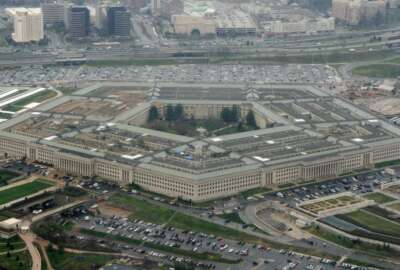Hubbard Radio Washington DC, LLC. All rights reserved. This website is not intended for users located within the European Economic Area.
What exactly should contractors disclose to the Defense Department about their climate exposure?
The Defense Department recently asked contractors, and any other interested parties, for comments about climate. In particular, climate-related disclosures, lik...
Best listening experience is on Chrome, Firefox or Safari. Subscribe to Federal Drive’s daily audio interviews on Apple Podcasts or PodcastOne.
The Defense Department recently asked contractors, and any other interested parties, for comments about climate. In particular, climate-related disclosures, like whether organizations measure their carbon output or post it publicly. Our guest on Federal Drive with Tom Temin says disclosures should go further than that. He’s the former FEMA administrator, now chief resilience officer at One Concern, Craig Fugate.
Interview transcript:
Tom Temin: Let’s begin with one concern. It’s an artificial intelligence company. Tell us what you’re up to these days after FEMA.
Craig Fugate: Well, it was an opportunity to answer a question I’ve had, why do we have to wait till disasters to know how bad something can be? And a lot of our tools and how we model disasters looks at historical events. But if you just kind of stay tuned to all of the weather related disasters, they’re all record setting, including the recent rainfall from Hurricane Ida up in the New England states, in New York City. And most of the tools that we have used in disaster preparedness don’t really capture how the risks are changing. And they don’t always look at the dependencies or relationships between a point on the map and maybe the function of that point on the map. A fire station isn’t just a building as a service area. So even if the buildings okay, but the roads are out, you can’t get to where you need to go, you’ve lost a function at fire station. So we’re using, the general term is machine learning. But really what it is, it’s this idea of looking at a lot of data, looking for patterns, and running multiple scenarios that increase the severity of an event to find out what could happen so that we have better tools to plan against versus only looking backwards at the historical events.
Tom Temin: All right. Sounds like the kind of dashboard FEMA itself could use on a regular basis?
Craig Fugate: Well, again, FEMA, when I was there, we’re using a tool called Hazus. It does some of this, but it was really an opportunity when the company approached me that I wanted to go further. I not only don’t want to look at what could happen, I also want to go if we change the environment, if we do projects to reduce the risk. Can we model that over scale and see what changes? So there’s a lot of things that I’m attracted to in what we’re doing, but probably the elevator speech is, what could happen before it happens to give people better tools to plan for the future events.
Tom Temin: All right, and getting to this DoD call on, I guess, primarily contractors, but anyone can weigh in. It’s a public comment that is now over a couple of weeks ago, but they were asking for disclosures about carbon output and so forth. What did you comment if you could distill it for us? And what do you think should go further than simply companies telling, here’s what I put out in carbon, and therefore I’m a polluter or here’s what I do to mitigate it?
Craig Fugate: Well, we took a different approach. I think a lot of this was reporting about climate impacts going forward. I’m telling people, the climate’s already changed. We’re seeing that right now. So not only should you be disclosing your carbon dioxide, other greenhouse gas emitters, you should be disclosing your vulnerabilities to extreme weather, and how that can affect the DoD’s mission. I mean, look in the various events that we’ve had, just example with COVID, how it disrupted supply chains. And so for DoD, we thought just asking how much carbon or how many greenhouse gases, that’s really looking at future climate. What can we do right now? If we’re already seeing impacts to DoD installations, how’s it impacting the supply chain? And have the suppliers done enough to disclose those risks to DoD? Because the Chairman of the Joint Chiefs, General Milley, has always been focused on readiness, and that readiness does not have an asterick that only when things are working, can we defend the country.
Tom Temin: In other words, if I’m a supplier of X-Y-Z spare parts, and DoD needs them, and a storm flattens my delivery distribution system, and my transportation suppliers can’t get through from where I am to where DoD is – that’s a climate risk that DoD needs to know about.
Craig Fugate: Right. If you look at Buy America, we have a lot of insource development a lot of expendables and parts that are constantly being produced and distributed. And so the question is, how long can DoD have a shutdown? Remember what Hurricane Katrina did to the Pascagoula shipyards and how that disrupted ship production? So these are things that we think from a DoD standpoint, they need to be asking their suppliers, what’s your plan, what’s your vulnerabilities and disclose that so they can make informed decisions about how those risks could affect the mission?
Tom Temin: We are speaking with Craig Fugate, he is chief resilience officer at One Concern, and a former FEMA administrator, and how should companies go about assessing their climate risk? I mean, I see my facilities, I see my people – what do I do now with all of this information that’s at least easily available?
Craig Fugate: That’s just it. A lot of companies have said, well we’ve never had a problem or we don’t think it’s a problem or it’s not discoverable. And we’re saying there’s too much information out there. You need to do what most any business should be doing is hazard analysis. What are the things that can happen, particularly in the natural hazards space, weather extremes, and the one we’re seeing a lot of is flooding? Also, long term power outages. We saw what Ida did down in Louisiana, there’s still places down there that haven’t received power. What are your vulnerabilities to that and what are you doing to mitigate that? And DoD needs to take this to the step of really going in is stress testing those answers, just like the SEC and Treasury stress test banks, DoD needs to look at their supply chain and go, these are critical suppliers that we need to make sure that downtime is measured in hours or days, not weeks, or months, or it could affect the mission. And if that’s not the case, they’re gonna have to go back with us contractors, and even look at what they can put into the contracts to bring that level up. That may cost more. But it’s got to be something DoD drives on. Some things, longer term disruptions may be tolerable, other things, short term disruptions aren’t tolerable. Where do we need to prioritize? And then look at geographically, have we distributed our production so that we’re not in a single point of failure or a region of the country that could knock out a key supply chain?
Tom Temin: For many years, organizations that operated crucial data centers often would have a backup facility somewhere else. And even for a given facility, they might have two utility contracts if they were available in case one utility failed. It sounds like what you’re saying is that type of thinking needs to extend to all of the operational aspects of a given concern. For example, do I need a second transportation supplier, should the first one be out of whack, or you name it?
Craig Fugate: And DoD already does this, this is not going to be something new to DoD. lWe have two shipyards that produce and build the submarines. If we ever lost that capacity, or went down to one, we could run the risk of not being able to produce submarines in the future. So DoD is already used to maintaining multiple supply chains for critical components. But when you start getting down the list, and you start moving away from a lot of the big ticket items, like aircraft and ships, that supply chain may not be as well understood. And again, just going back to our experience with COVID, we saw all kinds of disruptions that people didn’t anticipate. And even though you had US manufacturers, sometimes their supply chain for raw materials went all the way back across the globe. And that can be disrupted either through natural hazards that result in disasters, or other conflicts that may disrupt those supply chains.
Tom Temin: And we’ve been talking primarily about the Defense Department, which is the one that did that call for comments. But in many ways this applies across the government, doesn’t it?
Craig Fugate: Again, this was their specific request and we just looked at it and said, we would recommend going beyond just looking at the greenhouse gases and look at how resilient are the supply chains in the air of climate impacts that are occurring now.
Copyright © 2024 Federal News Network. All rights reserved. This website is not intended for users located within the European Economic Area.
Tom Temin
Tom Temin is host of the Federal Drive and has been providing insight on federal technology and management issues for more than 30 years.
Follow @tteminWFED
Related Stories
Related Topics





